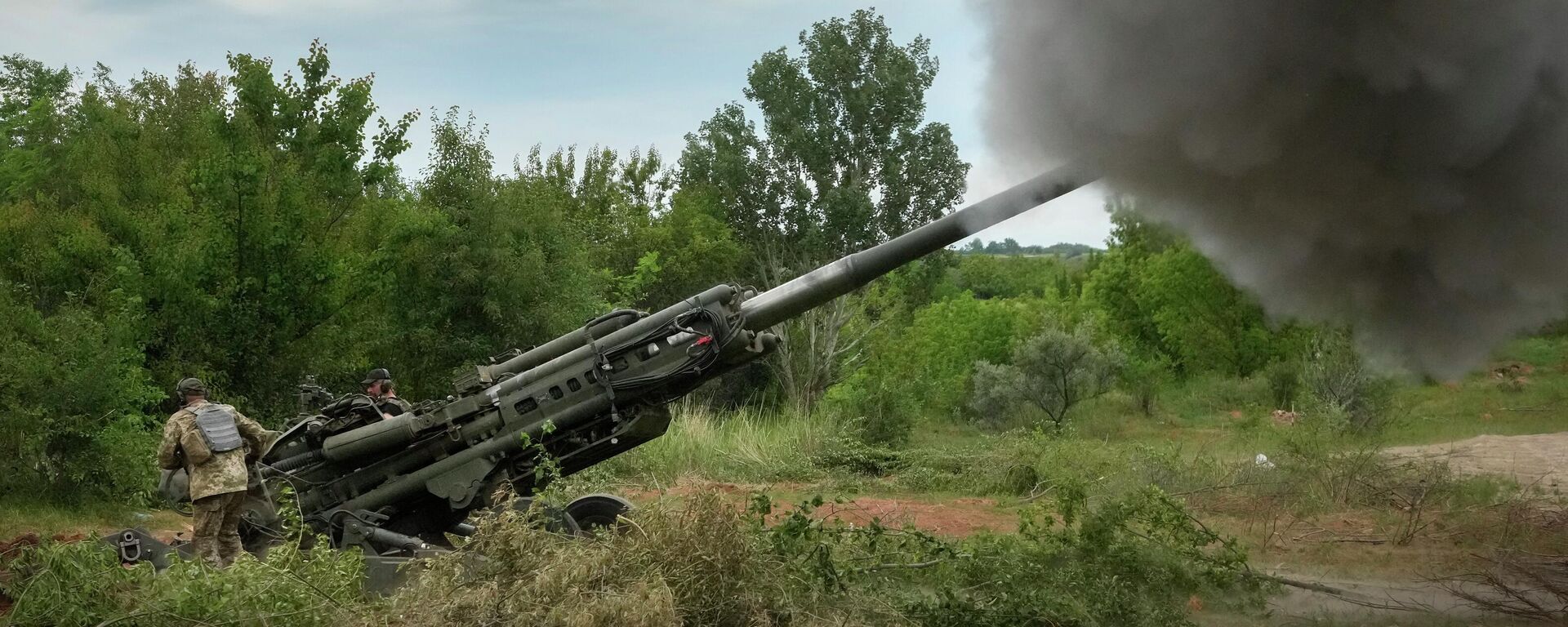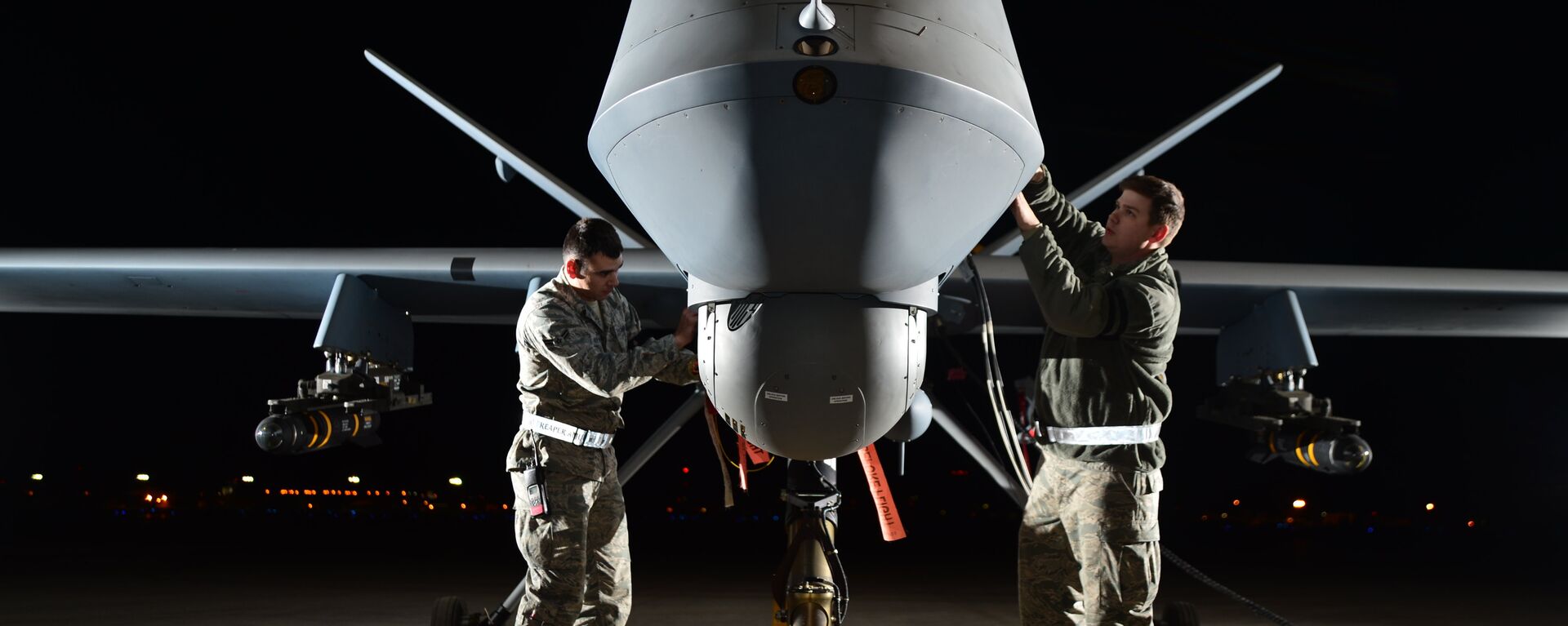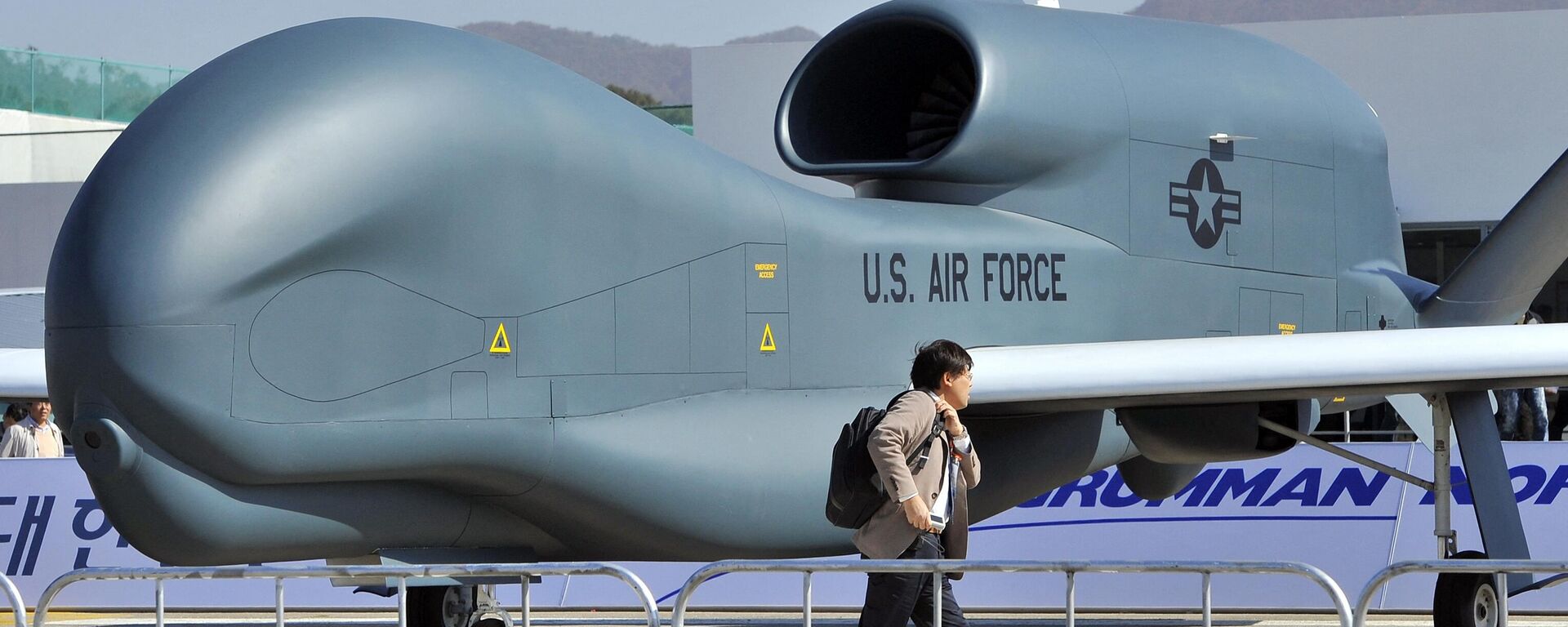https://sputnikglobe.com/20230316/mq-9-drone-incident-bidens-dangerous-escalation-1108466518.html
MQ-9 Drone Incident: Biden's Dangerous Escalation
MQ-9 Drone Incident: Biden's Dangerous Escalation
Sputnik International
Russian fighter aircraft brought down a US surveillance drone of the coast of Crimea. What this incident says about the current state of the war in Ukraine, and where Russia and the US might go from here.
2023-03-16T15:21+0000
2023-03-16T15:21+0000
2023-03-16T17:12+0000
world
russia
us
drone
black sea
black sea drone incident
https://cdn1.img.sputnikglobe.com/img/106415/61/1064156166_0:98:1920:1178_1920x0_80_0_0_845c6bda5a5aeece1b22eb5cc956bfcd.jpg
In 2015, the United States established a permanent training facility in Yavoriv, western Ukraine, for the express purpose of training Ukrainian soldiers for combat against Russia.At that time the conflict in Ukraine was an internal affair, pitting the Ukrainian Army against Ukrainians of ethnic-Russian background who had rebelled against a US-backed coup which, in February 2014, saw the constitutionally elected government of President Viktor Yanukovych replaced by a pro-American government.This new Ukrainian government, hand-picked by the US, was deeply infused with radical ultra-nationalism linked to the ideology of Stepan Bandera and the Organization of Ukrainian Nationalists, or OUN, which fought alongside Nazi Germany during the Second World War and whose members were responsible for the murder of hundreds of thousands of civilians.Many of the Ukrainians being trained by the US military were affiliated with the neo-Nazi Azov Battalion, an organization which many in the US Congress at the time found so odious that the passed an amendment to the defense authorization act prohibiting US taxpayer dollars from being used to train its members.These restrictions aside, there can be no doubt that the purpose of the US training mission in Ukraine was to prepare the Ukrainian military to go to war against Russia. That the US training not only instructed the Ukrainians troops on modern combined arms maneuver warfare, but also sought to elevate the Ukrainians to the same standard used to train the forces of the North Atlantic Treaty Organization (NATO), provided the first inkling that any future conflict between Ukraine and its disenfranchised ethnic Russian population that involved Russia would be far more than a simple confrontation between two regional neighbors, but a larger war between Russia and the US and NATO—the so-called "collective west", using Ukraine as a proxy.This reality was amplified further with the provision by the US and NATO of advanced anti-tank missile systems and other lethal military assistance.Even before Russia initiated the Special Military Operation, in February 2022, the United States, the United Kingdom, and NATO began a program of intelligence sharing with the Ukrainian armed forces at the highest levels. Once the Russian troops moved across the border, the nature of this intelligence relationship shifted away from providing indications and warning of an impending attack, to the provision of operational and tactical intelligence about Russian military disposition, capabilities, and intent that was used by Ukraine to target Russian forces.While the US and its NATO allies are understandably reticent about the nature of this intelligence, and the sources from which it is derived, over time it has become clear that every available intelligence collection platform is being used to gather relevant data about Russian military operations in support of the Special Military Operation.It is also clear that this intelligence is used by joint operational planning cells comprised of US/NATO/Ukrainian forces to develop targets in real time, which are then transmitted to Ukrainian forces.One of the more ubiquitous intelligence resources employed by the US in support of Ukraine is the MQ-9 Reaper. The MQ-9 is a large unmanned aerial vehicle (UAV) operated by the Air Force. It is remotely operated by a two-person team from a ground control station that is connected to the MQ-9 using satellite equipment. The team includes a qualified pilot who is responsible for flying the aircraft and an enlisted aircrew member who is charged with operating any onboard sensors or weapons the MQ-9 might be carrying.The MQ-9 has a wingspan of 66 feet, is 36 feet long, 12 feet high, and weighs approximately 4,900 pounds. It is capable of flying at altitudes as high as 50,000 feet and has a range of some 1,400 miles. It can carry a wide variety of weapons and intelligence collection pods. Each MQ-9 costs about $32 million. The MQ-9 Reapers operating over the Black Sea are flown out of a Romanian Air Force base in Campia Turzii by members of the US Air Force’ Detachment 1, 31st Expeditionary Operations Group.On March 14, 2023, an MQ-9 Reaper operating out of Campia Turzii was flying in international airspace over the Black Sea, west of Crimea. This was a standard flight profile for the MQ-9 Reaper, one that had the Russians concerned, given its proximity to sensitive Russian military installations.Ukraine had a history of launching operations against Russian forces in Crimea using aerial and underwater drones, and the potential for intelligence collected by the MQ-9 Reaper being used in support of such attacks was very real. For this purpose, the Russian military had declared certain areas off the coast of Crimea as being off limits.The US, however, does not recognize Russia’s claim to Crimea, or for that matter the four new territories of Kherson, Zaporozhye, Donetsk and Lugansk, that joined the federation following referendums held in September 2022 and, as such, does not recognize any claim regarding the establishment of no-fly zones by Russia in support of its ongoing military operations against Ukraine. The decision to fly the MQ-9 Reaper was made knowing Russia would object, or worse.Indeed, Russia dispatched a pair of Su-27 fighter aircraft to intercept the MQ-9 Reaper. After making 19 passes at the Reaper, the Su-27’s conducted what can only be described as aggressive maneuvering designed to either compel the MQ-9 Reaper to depart the area, or else bring it down. After one particular incident, which may or may not have involved one or more Su-27 aircraft dumping fuel onto the Reaper, the MQ-9 lost control and crashed into international waters off the coast of Crimea.It is believed that Russian forces dispatched from Crimea recovered most, if not all, the wreckage, including the top-secret intelligence pod that had been mounted under the left wing of the aircraft. If this is the case, critical US intelligence collection capabilities would have been compromised, allowing Russia to better protect itself from sensors like the one carried onboard the downed MQ-9 Reaper aircraft.While the US State Department has declared that the US will continue to fly missions in international airspace, the Commander of US forces in Europe, General Christopher Cavoli has ordered all MQ-9 Reaper operations to be halted pending a review of the incident and a decision on how best to proceed.The fact that the US is using the MQ-9 Reaper to fly in direct support of Ukrainian military forces make the aircraft a direct participant in the conflict, and as such a legitimate target for Russia. Russia’s decision not to shoot the MQ-9 down, but rather provide multiple opportunities for the US aircraft to disengage and leave the contested airspace, is indicative of Russia’s desire to avoid unnecessary escalation of the conflict, especially one that could have US and Russian forces engaged in direct combat.One of the options that the US could consider would be to fly the MQ-9 with a US fighter escort. But this would be contested by Russia, leading to the possibility of a dogfight that could result in casualties on both sides, and the probability of escalation. At the end of the day, the US will probably seek to fly an MQ-9 Reaper on a course that comes close to, but does not violate, a declared Russian no-fly zone, after which MQ-9 Reaper flights along the Crimean coast will probably discontinued.There are other ways to collect the intelligence that the MQ-9 Reaper gathers which do not put US military assets at risk, and which do not provide the possibility of military escalation between the US and Russia. Such a decision would be a sharp departure from the confrontational stance taken to date by the US when it comes to intelligence collection targeting Russia. However, the devolving military situation in Ukraine, with the Ukrainian military facing a decisive defeat in Bakhmut and in general, alters the risk-gain analysis that accompanies the decision to fly missions such as the one that resulted in the downed MQ-9 aircraft. With little chance of a Ukrainian victory in sight, the US will be looking for ways to deescalate, rather than escalate, its involvement in the Ukrainian conflict.Whether or not the MQ-9 Reaper incident will result in a top-down review of incidents of this nature, for example prompting the Biden administration to reflect on the apparent hypocrisy of the US approach toward responding to the Chinese balloon “threat”, namely by shooting the balloon down, while condemning the more restrained approach taken by Russia in responding to a genuine military threat on its borders in an active warzone, is yet to be seen. Such an abut-face would be unlikely, given the current political climate, where Russophobia runs rampant.The fact remains that as long as the US is engaged in the implementation of a wartime policy that seeks the strategic defeat of Russia, the possibility for rational, logic-based policy formulation and implementation on the part of the US is almost nil.The shortest path for the normalization of US-Russian relations lays in a decisive victory being achieved by Russia over Ukraine and the collective west in the shortest time possible. Such an outcome would force the US and its NATO allies to reexamine their approach toward Russia based upon the ne realities that would accrue from such an outcome.
https://sputnikglobe.com/20230311/us-lawmaker-washington-wants-russia-to-lose-in-ukraine-but-not-too-badly-1108280691.html
https://sputnikglobe.com/20230315/what-message-does-black-sea-reaper-crash-send-about-us-spying-missions-and-double-standards-1108426861.html
https://sputnikglobe.com/20230315/from-raven-to-coyote-how-many-military-drones-does-the-us-have-1108417947.html
russia
black sea
Sputnik International
feedback@sputniknews.com
+74956456601
MIA „Rossiya Segodnya“
2023
Scott Ritter
https://cdn1.img.sputnikglobe.com/img/07e6/0c/17/1105733958_0:0:334:334_100x100_80_0_0_b457e4e9c850ef224b0cc79059bb38df.jpg
Scott Ritter
https://cdn1.img.sputnikglobe.com/img/07e6/0c/17/1105733958_0:0:334:334_100x100_80_0_0_b457e4e9c850ef224b0cc79059bb38df.jpg
News
en_EN
Sputnik International
feedback@sputniknews.com
+74956456601
MIA „Rossiya Segodnya“
Sputnik International
feedback@sputniknews.com
+74956456601
MIA „Rossiya Segodnya“
Scott Ritter
https://cdn1.img.sputnikglobe.com/img/07e6/0c/17/1105733958_0:0:334:334_100x100_80_0_0_b457e4e9c850ef224b0cc79059bb38df.jpg
mq-9 drone incident, russia downs us drone, reaper drone, drone crash in black sea, us drones, us in ukraine, why does us send drones to ukraine, why america sends drones to ukraine
mq-9 drone incident, russia downs us drone, reaper drone, drone crash in black sea, us drones, us in ukraine, why does us send drones to ukraine, why america sends drones to ukraine
MQ-9 Drone Incident: Biden's Dangerous Escalation
15:21 GMT 16.03.2023 (Updated: 17:12 GMT 16.03.2023) A US surveillance drone crashed off the coast of Crimea after an encounter with a Russian fighter aircraft. What does this incident say about the current state of the war in Ukraine and where Russia and the US might go from here.
In 2015, the United States established a permanent training facility in Yavoriv, western Ukraine, for the express purpose of training Ukrainian soldiers for combat against Russia.
At that time the conflict in Ukraine was an internal affair, pitting the Ukrainian Army against Ukrainians of ethnic-Russian background who had rebelled against a US-backed coup which, in February 2014, saw the constitutionally elected government of President Viktor Yanukovych replaced by a pro-American government.
This new Ukrainian government, hand-picked by the US, was deeply infused with radical ultra-nationalism linked to the ideology of Stepan Bandera and the Organization of Ukrainian Nationalists, or OUN, which fought alongside Nazi Germany during the Second World War and whose members were responsible for the murder of hundreds of thousands of civilians.
Many of the Ukrainians being trained by the US military were affiliated with the
neo-Nazi Azov Battalion, an organization which many in the US Congress at the time found so odious that the passed an amendment to the defense authorization act
prohibiting US taxpayer dollars from being used to train its members.
These restrictions aside, there can be no doubt that the purpose of the US training mission in Ukraine was to prepare the Ukrainian military to go to war against Russia. That the US training not only instructed the Ukrainians troops on modern combined arms maneuver warfare, but also sought to elevate the Ukrainians to the same standard used to train the forces of the North Atlantic Treaty Organization (NATO), provided the first inkling that any future conflict between Ukraine and its disenfranchised ethnic Russian population that involved Russia would be far more than a simple confrontation between two regional neighbors, but a larger war between Russia and the US and NATO—the so-called "collective west", using Ukraine as a proxy.
This reality was amplified further with the provision by the US and NATO of advanced anti-tank missile systems and other lethal military assistance.
Even before Russia initiated the Special Military Operation, in February 2022, the United States, the United Kingdom, and NATO began a program of intelligence sharing with the Ukrainian armed forces at the highest levels. Once the Russian troops moved across the border, the nature of this intelligence relationship shifted away from providing indications and warning of an impending attack, to the provision of operational and tactical intelligence about Russian military disposition, capabilities, and intent that was used by Ukraine to target Russian forces.
While the US and its NATO allies are understandably reticent about the nature of this intelligence, and the sources from which it is derived, over time it has become clear that every available intelligence collection platform is being used to gather relevant data about Russian military operations in support of the Special Military Operation.
It is also clear that this intelligence is used by joint operational planning cells comprised of US/NATO/Ukrainian forces to develop targets in real time, which are then transmitted to Ukrainian forces.
One of the more ubiquitous intelligence resources employed by the US in support of Ukraine is the
MQ-9 Reaper. The MQ-9 is a large unmanned aerial vehicle (UAV) operated by the Air Force. It is remotely operated by a two-person team from a ground control station that is connected to the MQ-9 using satellite equipment. The team includes a qualified pilot who is responsible for flying the aircraft and an enlisted aircrew member who is charged with operating any onboard sensors or weapons the MQ-9 might be carrying.
The MQ-9 has a wingspan of 66 feet, is 36 feet long, 12 feet high, and weighs approximately 4,900 pounds. It is capable of flying at altitudes as high as 50,000 feet and has a range of some 1,400 miles. It can carry a wide variety of weapons and intelligence collection pods. Each MQ-9 costs about $32 million. The MQ-9 Reapers operating over the Black Sea are flown out of a Romanian Air Force base in Campia Turzii by members of the US Air Force’ Detachment 1, 31st Expeditionary Operations Group.
On March 14, 2023, an MQ-9 Reaper operating out of Campia Turzii was flying in international airspace over the Black Sea, west of Crimea. This was a standard flight profile for the MQ-9 Reaper, one that had the Russians concerned, given its proximity to sensitive Russian military installations.
Ukraine had a history of launching operations against Russian forces in Crimea using aerial and underwater drones, and the potential for intelligence collected by the MQ-9 Reaper being used in support of such attacks was very real. For this purpose, the Russian military had declared certain areas off the coast of Crimea as being off limits.
The US, however, does not recognize Russia’s claim to Crimea, or for that matter the four new territories of Kherson, Zaporozhye, Donetsk and Lugansk, that joined the federation following referendums held in September 2022 and, as such, does not recognize any claim regarding the establishment of no-fly zones by Russia in support of its ongoing military operations against Ukraine. The decision to fly the MQ-9 Reaper was made knowing Russia would object, or worse.
Indeed, Russia dispatched a pair of
Su-27 fighter aircraft to intercept the MQ-9 Reaper. After making 19 passes at the Reaper, the Su-27’s conducted what can only be described as aggressive maneuvering designed to either compel the MQ-9 Reaper to depart the area, or else bring it down. After one particular incident, which may or may not have involved one or more Su-27 aircraft dumping fuel onto the Reaper, the MQ-9 lost control and crashed into international waters off the coast of Crimea.
It is believed that Russian forces dispatched from Crimea recovered most, if not all, the wreckage, including the top-secret intelligence pod that had been mounted under the left wing of the aircraft. If this is the case, critical US intelligence collection capabilities would have been compromised, allowing Russia to better protect itself from sensors like the one carried onboard the downed MQ-9 Reaper aircraft.
While the US State Department has declared that the US will continue to fly missions in international airspace, the Commander of US forces in Europe, General Christopher Cavoli has ordered all MQ-9 Reaper operations to be halted pending a review of the incident and a decision on how best to proceed.
The fact that the US is
using the MQ-9 Reaper to fly in direct support of Ukrainian military forces make the aircraft a direct participant in the conflict, and as such a legitimate target for Russia. Russia’s decision not to shoot the MQ-9 down, but rather provide multiple opportunities for the US aircraft to disengage and leave the contested airspace, is indicative of Russia’s desire to avoid unnecessary escalation of the conflict, especially one that could have US and Russian forces engaged in direct combat.
One of the options that the US could consider would be to fly the MQ-9 with a US fighter escort. But this would be contested by Russia, leading to the possibility of a dogfight that could result in casualties on both sides, and the probability of escalation. At the end of the day, the US will probably seek to fly an MQ-9 Reaper on a course that comes close to, but does not violate, a declared Russian no-fly zone, after which MQ-9 Reaper flights along the Crimean coast will probably discontinued.
There are other ways to collect the intelligence that the MQ-9 Reaper gathers which do not put US military assets at risk, and which do not provide the possibility of military escalation between the US and Russia.
Such a decision would be a sharp departure from the confrontational stance taken to date by the US when it comes to intelligence collection targeting Russia. However, the devolving military situation in Ukraine, with the Ukrainian military facing a decisive defeat in Bakhmut and in general, alters the risk-gain analysis that accompanies the decision to fly missions such as the one that resulted in the downed MQ-9 aircraft. With little chance of a Ukrainian victory in sight, the US will be looking for ways to deescalate, rather than escalate, its involvement in the Ukrainian conflict.
Whether or not the
MQ-9 Reaper incident will result in a top-down review of incidents of this nature, for example prompting the Biden administration to reflect on the apparent hypocrisy of the US approach toward responding to the Chinese balloon “threat”, namely by shooting the balloon down, while condemning the more
restrained approach taken by Russia in responding to a genuine military threat on its borders in an active warzone, is yet to be seen. Such an abut-face would be unlikely, given the current political climate, where Russophobia runs rampant.
The fact remains that as long as the US is engaged in the implementation of a wartime policy that seeks the strategic defeat of Russia, the possibility for rational, logic-based policy formulation and implementation on the part of the US is almost nil.
The shortest path for the normalization of US-Russian relations lays in a decisive victory being achieved by Russia over Ukraine and the collective west in the shortest time possible. Such an outcome would force the US and its NATO allies to reexamine their approach toward Russia based upon the ne realities that would accrue from such an outcome.







